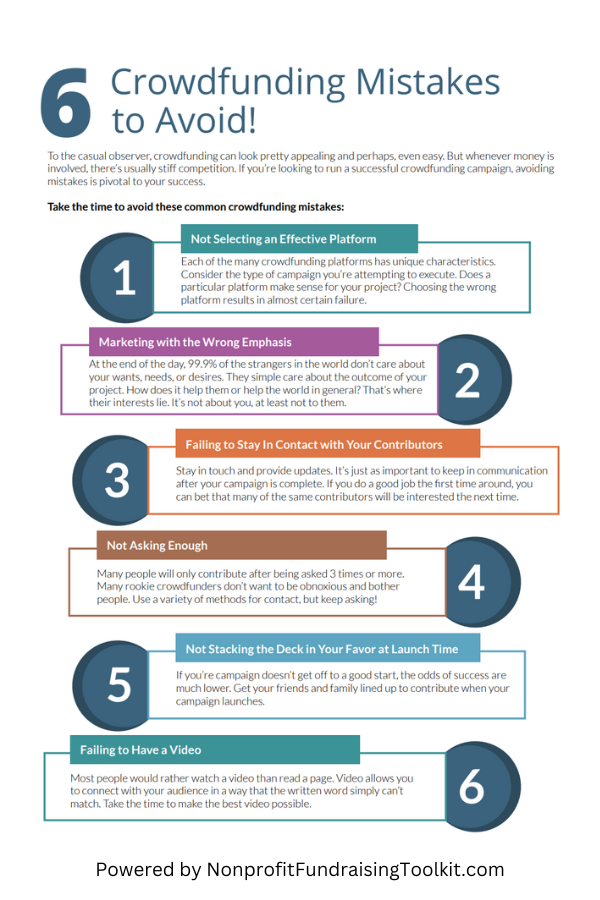
Crowdfunding for nonprofits: Will it replace fundraising campaigns? What will your donors think?
Crowdfunding has become an increasingly popular way for nonprofits to raise funds for their causes. It involves gathering small donations from a large number of people through online platforms like Kickstarter, GoFundMe, and Indiegogo. While crowdfunding can be an effective way to raise funds, it’s important for nonprofit leaders to understand its pros and cons and to approach it with a solid plan in mind. In this blog post, we’ll discuss the pros and cons of crowdfunding for nonprofits and what they need to pay attention to.
Pros:
Low cost: Crowdfunding campaigns are relatively low-cost compared to traditional fundraising methods, making it an attractive option for nonprofits with limited budgets.
Reach: Crowdfunding platforms have a large audience, and campaigns can quickly go viral, reaching people across the globe. This can help nonprofits reach new donors who may not have otherwise heard of their cause.
Engagement: Crowdfunding campaigns can be a great way to engage with donors and build a sense of community around a cause. Donors feel more invested in the success of the campaign and the organization when they’re actively involved.
Validation: A successful crowdfunding campaign can provide validation for an organization and its mission, demonstrating to donors and the broader public that there’s significant interest and support for the cause.
Cons:
Risk: Crowdfunding is not a guaranteed way to raise funds, and there’s always the risk of not reaching the fundraising goal. This can be demoralizing for nonprofits and impact their future fundraising efforts.
Time-intensive: Running a successful crowdfunding campaign requires a significant amount of time and effort, from planning the campaign to creating compelling content, promoting the campaign, and engaging with donors.
Platform fees: Most crowdfunding platforms charge fees to nonprofits, which can eat into the funds raised. Nonprofits need to carefully consider these fees and how they will impact their overall fundraising efforts.
Oversaturation: With so many nonprofits and individuals using crowdfunding platforms, it can be difficult to stand out from the crowd and get noticed by potential donors.
What to pay attention to:
Goal setting: Nonprofits need to set realistic fundraising goals and create a detailed plan for how they will achieve them. This includes setting a timeframe for the campaign and determining how much they need to raise to achieve their objectives.
Storytelling: Crowdfunding campaigns rely on compelling stories and visuals to attract donors. Nonprofits need to invest time and effort in creating a narrative that resonates with potential donors and communicates the impact of their work.
Promotion: Crowdfunding campaigns need to be promoted widely and consistently through social media, email marketing, and other channels. Nonprofits should leverage their networks and supporters to help spread the word and drive donations.
Donor engagement: Nonprofits need to engage with donors throughout the campaign, thanking them for their contributions and updating them on progress towards the fundraising goal. This can help build a sense of community around the campaign and encourage donors to become long-term supporters of the organization.
There’s no doubt that crowdfunding can be a powerful tool for nonprofits to raise funds and engage with donors, but it requires careful planning and execution to be successful. Nonprofit leaders should weigh the pros and cons of crowdfunding and develop a comprehensive strategy that takes into account their unique goals, audience, and resources. With the right approach, crowdfunding can be an effective way for nonprofits to advance their missions and make a positive impact in their communities.
Yes, crowdfunding has blossomed over the past several years, and quite a few nonprofit organizations have dipped their toe into the water. But there are a few mistakes you should be aware of; here are 6 of them to try and avoid at all costs:

- Content curated by search on internet and OpenAI with formatting and editing by the JPC staff.